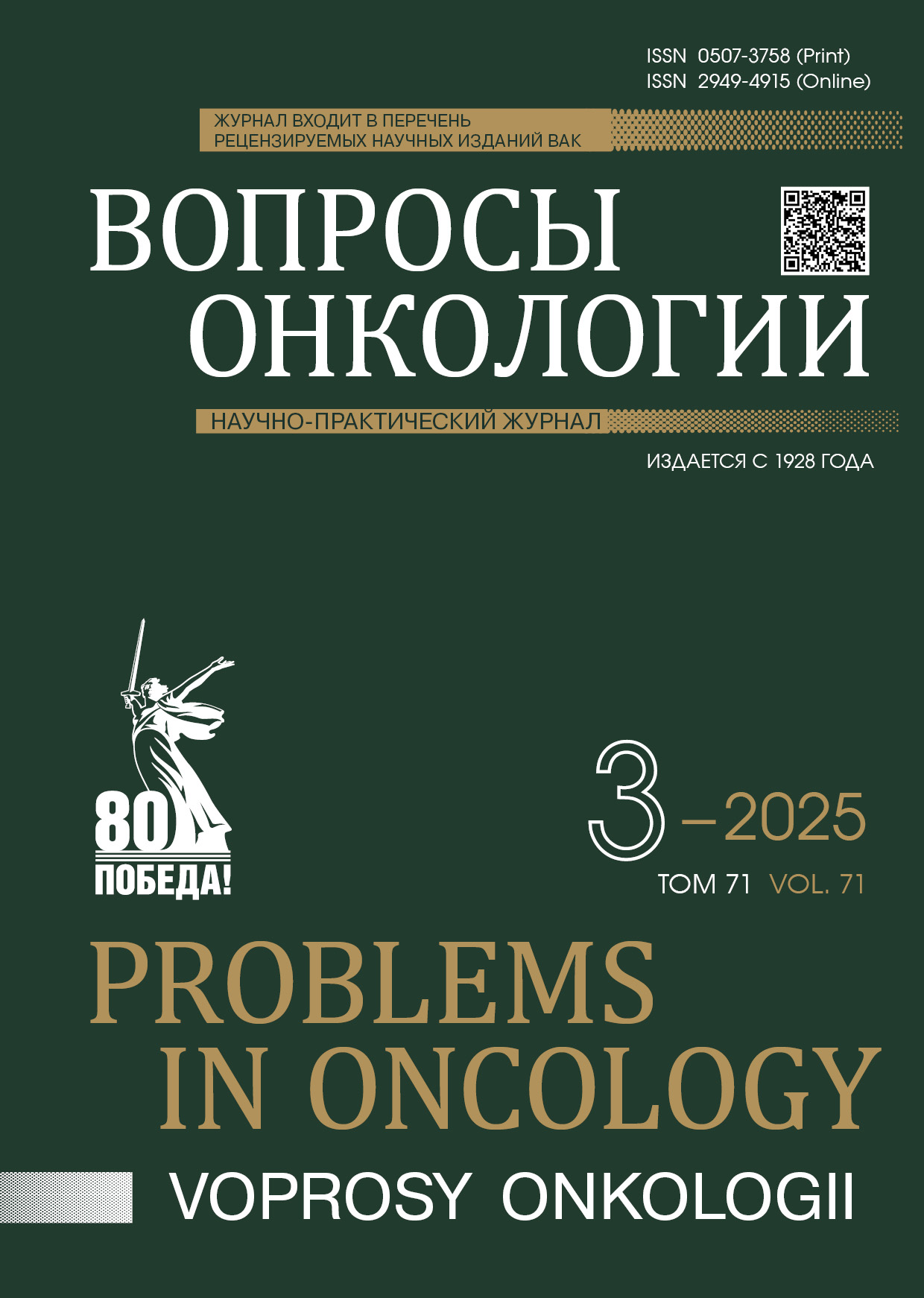Abstract
Introduction. Tumor heterogeneity is a set of various biological characteristics inherent in individual groups of cells within a single neoplasm. Due to the high heterogeneity of luminal breast cancer (BC), anti-tumor therapy can alter the cell structure and also affect the selective selection of a pre-existing cell clone that is often more aggressive and resistant to anti-tumor treatment, but not widely represented in the primary tumor. Detection of changes in the immunohistochemical (IHC) subtype of BC can be of great prognostic and predictive value. The study of BC heterogeneity is also important for understanding the mechanisms of tumor resistance to treatment.
Aim. To assess the effect of discordance of IHC characteristics between the primary tumor and metastasis (recurrence) and IHC tumor subtype conversion on relapse-free survival (RFS).
Materials and Methods. Based on the St. Petersburg State Budgetary Healthcare Institution «City Clinical Oncology Dispensary» (Chief Physician, MD, Prof. E.E. Topuzov), the authors of the article retrospectively and prospectively analyzed cases of local recurrence and/or dissemination of luminal BC, identified from 2019 to 2024. All patients underwent histological verification of the primary tumor and biopsy of the recurrent/metastatic lesion prior to starting drug treatment. Paired biopsies were subjected to histological and IHC examination to determine surrogate tumor subtypes. The authors assessed RFS rates according to the presence of discordant IHC features and the presence of IHC subtype conversion.
Results. The study included 100 patients. The authors confirmed changes in tumor immunophenotype (discordance between paired biopsies) due to intratumoral heterogeneity of BC in 57 % of cases. Median RFS in the groups with and without IHC discordance was 36 (95 % CI 24-58) months vs 48 (95 % CI 36-63) months, log rank p = 0.049. A significant reduction in the risk of progression was observed in the group of patients who received tamoxifen as adjuvant antihormonal therapy (HR 0.23 [95 % CI 0.13-0.41], p < 0.001).
Conclusion. BC is a highly heterogeneous disease, which is confirmed by the discordance (57 % of cases) of immunohistochemical characteristics in paired biopsies of the primary tumor before treatment and metastatic/recurrent foci identified in the study. IHC discordance is associated with a lower median RFS, probably due to the acquisition of tumor resistance to antihormonal therapy.
References
Геращенко Т.С., Завьялова М.В., Денисов Е.В., et al. Внутриопухолевая морфологическая гетерогенность рака молочной железы как фактор, отражающий метастатический потенциал и чувствительность опухоли к химиотерапии. Acta Naturae. 2017; 1(32). [Gerashchenko T.S., Zavyalova M.V., Denisov E.V., et al. Intratumor morphological heterogeneity of breast cancer as a factor reflecting the metastatic potential and tumor sensitivity to chemotherapy. Acta Naturae. 2017; 1(32). (in Rus)].
Koboldt D.C., Fulton R.S., McLellan M.D., et al. Comprehensive molecular portraits of human breast tumours. Nature. 2012; 490: 61-70.-DOI: 10.1038/nature11412.
Cheang M.C.U., Martin M., Nielsen T.O., et al. Defining breast cancer intrinsic subtypes by quantitative receptor expression. Oncologist 2015; 20(5): 474-82.-DOI: 10.1634/theoncologist.2014- 0372.
Schettini F., Braso ́-Maristany F., Kuderer N.M., Prat A. A perspective on the development and lack of interchangeability of the breast cancer intrinsic subtypes. NPJ Breast Cancer. 2022; 8: 85.-DOI: 10.1038/S41523-022- 00451-9.
Lüo ̈nd F., Tiede S., Christofori G. Breast cancer as an example of tumour heterogeneity and tumour cell plasticity during malignant progression. Br J Cancer. 2021; 125(2): 164-75.-DOI: 10.1038/s41416-021-01328-7.
Falato C., Schettini F., Pascual T., et al. Clinical implications of the intrinsic molecular subtypes in hormone receptor-positive and HER2-negative metastatic breast cancer. Cancer Treat Rev. 2023; 112: 102496.-DOI: 10.1016/j.ctrv.2022.102496.
Bastien R.R.L., Rodríguez-Lescure A ́., Ebbert M.T.W., et al. PAM50 breast cancer subtyping by RT-qPCR and concordance with standard clinical molecular markers. BMC Med Genomics. 2012; 5(1).-DOI: 10.1186/1755-8794-5-44.
Bergamino M.A., Lo ́pez-Knowles E., Morani G., et al. HER2-enriched subtype and novel molecular subgroups drive aromatase inhibitor resistance and an increased risk of relapse in early ER+/HER2+ breast cancer. EBioMedicine. 2022; 83: 104205.
Prat A., Chaudhury A., Solovieff N., et al. Correlative biomarker analysis of intrinsic subtypes and efficacy across the MONALEESA phase III studies. J Clin Oncol. 2021; 39(13): 1458-67.-DOI: 10.1200/ JCO.20.02977.
Cejalvo J.M., de Duen ̃as E.M., Galv ́an P., et al. Intrinsic subtypes and gene expression profiles in primary and metastatic breast cancer. Cancer Res. 2017; 77: 2213-21.-DOI: 10.1158/0008-5472.CAN- 16-2717.
Aftimos P., Oliveira M., Irrthum A., et al. Genomic and transcriptomic analyses of breast cancer primaries and matched metastases in AURORA, the breast international group (BIG) molecular screening initiative. Cancer Discov. 2021; 11: 2796-811.-DOI: 10.1158/2159- 8290.CD-20-1647.
Bidard F-C., Hardy-Bessard A-C., Dalenc F., et al. Switch to fulvestrant and palbociclib versus no switch in advanced breast cancer with rising ESR1 mutation during aromatase inhibitor and palbociclib therapy (PADA-1): a randomised, open-label, multicentre, phase 3 trial. Lancet Oncol. 2022; 23(11): 1367-77.
Башлык В.О., Кудайбергенова А.Г., Артемьева А.С., et al. Смена фенотипа рака молочной железы (er, PR, HER2) после неоадъювантного лечения. МС. 2018; 10.-URL: https://cyberleninka.ru/article/n/smena-fenotipa-raka-molochnoy-zhelezy-er-pr-her2-posle-neoadyuvantnogo-lecheniya. [Bashlyk V.O., Kudaibergenova A.G., Artemyeva A.S., et al. Change in the phenotype of breast cancer (er, PR, HER2) after neoadjuvant treatment. МС. 2018; 10.-URL: https://cyberleninka.ru/article/n/smena-fenotipa-raka-molochnoy-zhelezy-er-pr-her2-posle-neoadyuvantnogo-lecheniya. (In Rus)].

This work is licensed under a Creative Commons Attribution-NonCommercial-NoDerivatives 4.0 International License.
© АННМО «Вопросы онкологии», Copyright (c) 2025

